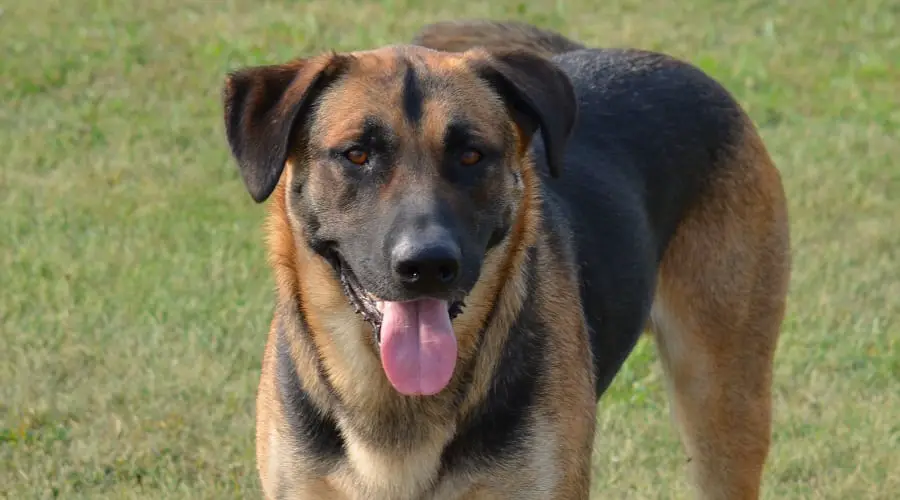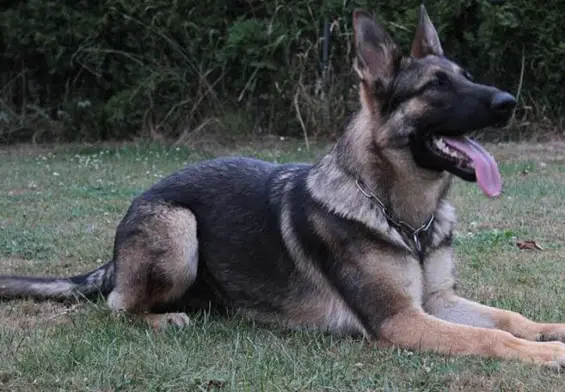Labrador Retriever German Shepherd Mix Guide (aka Sheprador)
Different dog breeds will suit different families; dogs have varying personalities and traits–they will behave differently around people or children and at times towards strangers. They also have varying energies and exercise requirements. Their personalities often determine how easy or complicated their training can be.
When looking for a pet dog, you will come across many breeds. You have perhaps or will stumble upon Labrador Retrievers–they are America’s most popular dog breed. Many people keep them for their gentle and adorable nature; they also have plenty of energy and love the outdoors.
Besides Labradors are German Shepherds, perhaps America’s second most popular dog breed. Many people keep them for their intelligence and aptness; they are quick to learn and enjoy exercises. They also love families and children and help the blind, the old, and even the military.
The two dogs, the Labrador and the German Shepherd have been bred over the years, resulting in a Sheprador mix with high intelligence, and loyalty. They are also energetic and friendly; they do well around families and love playing with children. That is not all about these dogs.
When looking to purchase a Sheprador, you may want to know more than their major traits. Information about their sizes is as important as about their health, grooming needs, exercise, and general care. If you will buy one from a breeder, then information about their parentage among more is critical.
We will discuss what you need to know about Shepradors from the German Shepherd Mix list; we will also look into some of the ways you can provide them with the best care and maintenance.
Summary
Summarily, you will find the Sheprador very popular; most people keep them as family pets. They love children and when exposed or socialized early, will do well in their company. The same is true about their interaction with other dogs and small pets.
These are intelligent, protective, loyal, obedient, loving, and friendly dogs. They grow to an average of 22 to 26 inches and weigh between 49 and 88 pounds. Most live for 10 to 12 years; they also have double coats that are short and dense.
You may not find these dogs to be hypoallergenic; due to their seasonal shedding, which changes from moderate to high, they require regular brushing and moderate grooming. Shepradors may not need professional grooming.
While they are friendly and loving, these dogs do not appreciate too much obtrusion of their personal space; therefore, they may not respond well to too much touching. On the other hand, their socialization makes it difficult for them to be comfortable in their own company; they should be around people.
While their double coats serve these dogs in cold climates, it becomes a challenge in warm environments or hot climates–they can quickly overheat. Shepradors require regular exercise and stimulation; nonetheless, they are highly receptive and thus easy to train.
The ease of their training and management make these dogs suitable for first-time parents. However, ensure that they get ample space for their movement and plays both indoors and outdoors. In that case, you will find that an apartment would not make their best home.
These dogs moderately gain weight. Health concerns common to the breed include allergies, obesity, heart complications, ear infections, joint dysplasia, and bloat. A new puppy can cost you between $195 and $850; their yearly maintenance can cost you at least $1,000.
Labrador Retrievers
Labrador retrievers are historically happy and friendly dogs, while the German shepherd is additionally protective and active. It is not common to attain successful mixes from varying body types but the Sheprador comes as an easily lovable breed with a blend of both personalities; they are healthy and strong dogs.
German Shepherds
German Shepherds trace their history to the 19th century German vet, Max von Stephanitz who was drawn by the country’s sheepdogs’ traits. It was after a show that he would acquire his first Horand von Grafath, after which he would introduce German Shepherds as breeds
Labradors have humble beginnings, tracing their history to the Portugues, Irish, and Old English mixes; they are related to the St. John’s water dogs. Most people first kept Labs as sporting dogs and due to their great retrieval skills, they have over the years excelled in sporting and as working dogs.
Shepradors
First interbred by accident, the German Shepherd and Labrador give rise to one of the most lovable breeds, the Sheprador. These dogs are known by many as designer breeds and while they may not match some of the biggest and common names in homes and the market, they make an impression.
Shepradors are still in the early stages of interbreeding. Therefore, their traits and behaviours cannot be easily predicted; most turn out different from their parents while others bear similar characteristics. They are the first-generation breed and it may take some time before much about their appearance can be determined beforehand.
Moreover, their body appearances tend to take the same path, with most Shepradors exhibiting features common to the German Shepherd and many others taking after their Labrador parents. Therefore, they can be a variety of black, yellow, gray, white, sable or tan in coat color; they can also have floppy ears and stout muzzles as the Labrador does, or alert ears and slender muzzles as the GSD does.
Making an early determination mostly depends on when you introduce your dog into the family. Parents who adopt them at an early age and raise the Sheprador to maturity may not know what to expect and will learn much about their traits as they grow. On the other hand, those who adopt older dogs, often full-grown, get an entirely developed Sheprador with an established character.
Therefore, in such a case, you will have access to information on the dog’s coat color, type, their weight, size and even overall looks. We have different preferences; with Shepradors, that could mean you either find prior information on a dog necessary or you take the process of raising more essential–at the end of the day, what works for you is unique to your situation and circumstances.
Grooming
Grooming is critical to every dog’s life. You will find Shepradors to be heavy shedders. They have dense coats that serve them best in winters and summers, regulating both extremes in temperatures. They then shed a lot during spring and autumn. During this time, you will have to keep up with their maintenance; it is not a difficult thing, when well done, it could feel easier after every season.
How will you know if you have done it well? For one, you would not want your dog’s fur all over the house; they also need to look neat! Brushing will often require a good-quality brush or basic wire and some of your daily time. You may also want to consider getting a vacuum cleaner for your house.
Should you bathe your dog? It is okay to, but it is advisable that you do it only once in a while. Whenever it is possible, brush their hair; however, if they get themselves too dirty to tidy with a brush, then you can consider a simple bathe. Of course, you should not use regular conditioners or shampoo meant for human hair; available, are soaps suitable for use on dogs–use one.
Size and Weight
German Shepherds and Labrador Retrievers are not that dissimilar in weight and size. Therefore, a mix of these two breeds will not be that different in size compared to pure breed offspring of each breed.
German shepherds can grow to weigh fifty to ninety pounds once fully grown, while Labrador Retrievers can weigh ranging from fifty to about seventy-five pounds. A Sheprador will then weigh anywhere within that range depending on other factors.
The same goes for their heights. German Shepherds can be as tall as twenty-two to twenty-six inches tall, whereas Labradors range from about twenty-two to twenty-five inches. Their offspring once again falls in this range.
Typical characteristics do not change in mixed breeds. Naturally, female dogs will be smaller in size compared to their male counterparts. However, since we are talking about a cross between a Shepherd and a Lab, the female dogs will be larger than other female dogs of other breeds.
Temperament
The personalities of both dog breeds are almost identical except for a few key differences. Labradors are social dogs. They are outgoing and are friendly with people. How well they interact with people depends on how well they were socialized.
They are always friendly with other animals and can coexist peacefully with them. This is why they are preferred in homes that keep other animals either as pets or for rearing. They show their love openly, and that is how they get along with children.
They love playing and having fun, and that makes them very fun to be around. German Shepherds, on the other hand, give off an air of authority. They are always keen and are brave, which makes them excellent guard dogs.
They are smart and loyal to their human companions, and this loyalty is extended to their family. They love carrying out tasks, so their preferred mode of exercise has to include challenges. This sharpens their senses and prevents them from being destructive.
The Sheprador inherits the qualities of each parent. Hence they are smart, full of energy and can be around people of all ages comfortably. They are easy to train and are very loveable. They also inherit the trait unique to the German Shepherd of being protective.
However, the success of their training depends on whether you socialize them as puppies. They will grow to have a bond with people and have patience when dealing with children. Exposure to environments with people will make them grow well socialized.
Socialization
Socialization is the process of acquainting your dog with several different elements of their environment. That way, they can grow up to accept people, other animals, objects and places as part of their environment and not react adversely to them.
Socialization has to be done correctly for the best results. Otherwise, even friendly dogs can turn to be reclusive and terrifying. Shepradors inherit their curiosity for new people from their Labrador parents.
Therefore, as puppies, they should be introduced to new people. The interactions with these people should be positive to ensure that they look forward to similar interactions. The people should be gentle and speak to them in a non-threatening way.
Similarly, their initial interactions with other animals have to be with gentle animals. If they play with bullying animals, they may grow to bias against individual animals and unfamiliar animals.
Training and Exercise
Labs and Shepherds are intelligent and energetic dogs. Their exercises have to include not only physical challenges but also mental stimulation. An hour every day for their exercises is sufficient to keep them in good health.
Playing games with them during exercise satisfies their need for mental stimulation while giving them the exercise they need. During their playtime, it is advised that the human companions be present to steer them away from mischief brought on by boredom.
The Shepradors are very eager to learn, making them easy to train and gives them the ability to learn more specialized skills quickly. They are sometimes used as service dogs because of their need to have a purpose and goals.
Basic skills training is mandatory to ensure they are not a danger to humans and give them the tools necessary to navigate and interact in a human-centered environment. However, these skills can be built upon with other more specialized training.
They can be trained as trackers and work in search and rescue. They can also improve their smelling to be able to sniff out contraband. They can also learn to provide therapeutic services such as emotional support.
As they grow older, some health issues may surface that may hinder your dog’s exercise and training. It is advisable always to monitor them during playtime to be able to detect any developing issues early.
Health and Care
One of the pleasant side effects of crossbreeding is eradicating health risks that are common in pre breeds. However, that is not always the case. Mixing a Labrador and a German Shepherd could lead to an improvement in eating habits, but there are still other risks.
The health of Labs and German Shepherds are almost similar, which makes it possible to predict the potential risks in Shepradors easily. They need regular visits to the veterinary for check-ups and increase the chances of early detection of diseases.
They should eat food that is of high quality, and their treats should be well regulated. The usual health issues include hip and elbow dysplasia, retinal atrophy, obesity, ear infection, gastric dilation volvulus, panosteitis and chronic degenerative radiculomyelopathy.
Family Pet
The Sheprador is very protective of the family it is adopted in. They are excellent guardians for children as they can steer them away from danger and keep nefarious people away. They are also fun on outings and provide great entertainment.
They are suitable for active families because Sheprador requires constant activity. They still need supervision when they are with children, but that is to watch out for small accidents.
Rescuing
Rescue dogs may not be easy to identify their breed. Some shelters can run DNA tests, but even that sometimes cannot be exact. The only times it is easy is when the rescue dog is an owner surrender. Some shelters are breed-specific, so you can visit them to get a Lab-Shepherd mix.
Puppy
Finding Sheprador puppies is not as tricky as rescuing Shepradors. They are available through breeder databases and other listings. You only need to be sure the breeders are licensed. The puppies and their parents should not be living in deplorable conditions.
Raising a Sheprador
They need to learn basic commands as puppies to discourage bad behavior and reward good behavior. Socializing them falls under basic training and should be done correctly. They should also be taught to go outside when they need to relieve themselves.
It would be best if you took them to the vet regularly for check-ups. This ensures that their health is monitored continuously, and appropriate adjustments can be made to improve their health status. They will also need to be vaccinated to reduce the risk of transmission of diseases.
They need good quality food to help them grow strong and healthy. They also need regular feeding schedules to keep them in shape and reduce the risks associated with overfeeding. Feed them treats to reward good behavior and excellence in training.
They should not be fed leftovers because the chemical make-up and high-fat content out foods have may be too much to handle for a puppy. There should always be fresh water for them to drink.
Watch out for dehydration if they do not get enough water. It would be best if you also looked out for waterborne diseases from drinking contaminated water. Their bowls should be cleaned often to reduce the chances of infection.
Conclusion
Shepradors are excellent family pets. Before acquiring one, you need to do your due diligence. Get as much information as possible on their history, health, feeding habits and training. To take care of the dogs, you could also purchase a training manual and guide.





